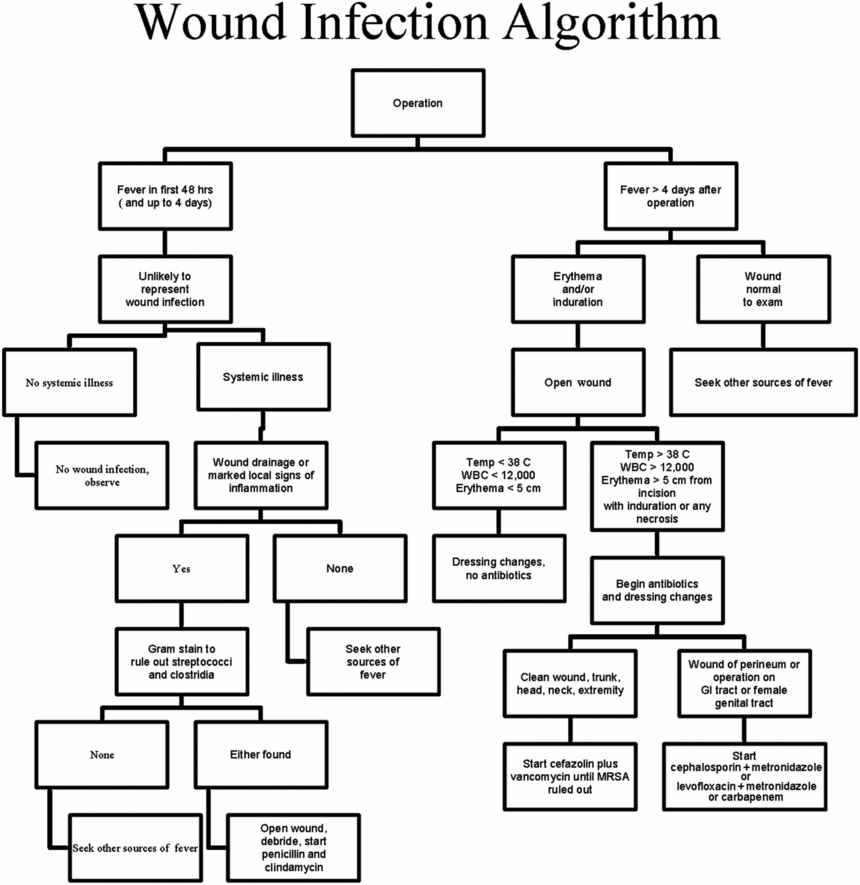| NHSN risk index | ||||||
|---|---|---|---|---|---|---|
| NRC class | 0 | 1 | 2 | 3 | All | Maximum ratio (NRC)a |
| Clean | 1.0 | 2.3 | 5.4 | – | 2.1 | 5.4 |
| Clean-contaminated | 2.1 | 4.0 | 9.5 | – | 3.3 | 4.5 |
| Contaminated | – | 3.4 | 6.8 | 13.2 | 6.4 | 3.9 |
| Dirty | – | 3.1 | 8.1 | 12.8 | 7.1 | 4.1 |
| All | 1.5 | 2.9 | 6.8 | 13.0 | 2.8 | – |
| Maximum ratio (NHSN)a | 2.1 | 1.7 | 1.8 | 1.0 | – | – |
a Ratio of the lowest to the highest infection rate in wound class or risk index. Note that the highest maximum ratio for any of the NHSN indices is 2.1, whereas the lowest maximum ratio for any of the NRC wound classes is 3.9. Clearly, the NHSN index more accurately describes the infection risk of operative procedures.
Diagnosis
The diagnosis of postoperative wound infection is obvious when the wound opens and discharges pus. However, the diagnosis is ideally made earlier and prompt therapeutic intervention undertaken. It is rare for a postoperative wound infection to be clinically evident before the fourth or fifth postoperative day. The sole exceptions to this are infections caused by β-hemolytic streptococci and by histotoxic Clostridium species and, more rarely, wound toxic shock. These infections can be clinically evident within fewer than 24 hours, and although they are rare, they tend to be devastating. The wound of any patient with severe systemic signs of infection during the first few days after an operation should be inspected for signs of infection (Figure 109.1). Streptococcal infections are marked by local signs of inflammation and at times an exudate containing white blood cells (WBCs) and gram-positive cocci. Clostridial infections lack signs of inflammation and produce a thin exudate lacking WBCs because of the action of clostridial exotoxins, but gram-positive rods without spore formation are evident on Gram smear. Thirteen cases of wound toxic shock were confirmed by the CDC during an 18-month period, representing less than 1% of all cases of toxic shock reported during that period. More than half of these cases presented within 48 hours of an operation. The earliest signs were fever, diarrhea, and vomiting. Profuse watery diarrhea, erythroderma, and hypotension were also characteristic. Initially, local signs of wound infection were often absent. Drainage and irrigation of the wound in combination with a systemic antistaphylococcal antibiotic is recommended. Although most wound infections are diagnosed between 5 and 15 days after the procedure, in some cases, diagnosis may be delayed considerably. This is more likely with wounds with a significant amount of tissue overlying the area such as abdominal wounds in morbidly obese patients and wound infections under chest wall musculature following a posterolateral thoracotomy.

Figure 109.1 Wound infection algorithm. (With permission from Jarvis WR, ed. Hospital Infections, 5th edn. Philadelphia: Lippincott Willliams & Wilkins; 2007.)
Because most patients have some fever in the first several days after a major operative procedure such as abdominal exploration or thoracotomy, fever is not a specific sign of postoperative infection (Figure 109.2). It is tempting for the surgeon to continue prophylactic antibiotics or to restart antibiotics if the patient shows early postoperative fever, but this impulse should be resisted because these infections will not resolve without opening the wound. When antibiotics are given without a commitment to open the wound, the most likely results are a delay in diagnosis and definitive treatment, a consequent increase in morbidity, and risk of additional complication such as wound dehiscence or herniation. A few surgical wounds exhibit erythema adjacent to the incision, either concentrated around skin sutures or staples or diffusely. In the absence of marked induration and/or drainage, this erythema usually does not indicate wound infection. The average clinician will be sorely tempted to prescribe antibiotics for a patient with such a wound, but most resolve without any specific treatment, and no data suggest that administration of antibiotics in such a situation will prevent the need to open the wound for a real infection.
Stay updated, free articles. Join our Telegram channel

Full access? Get Clinical Tree





